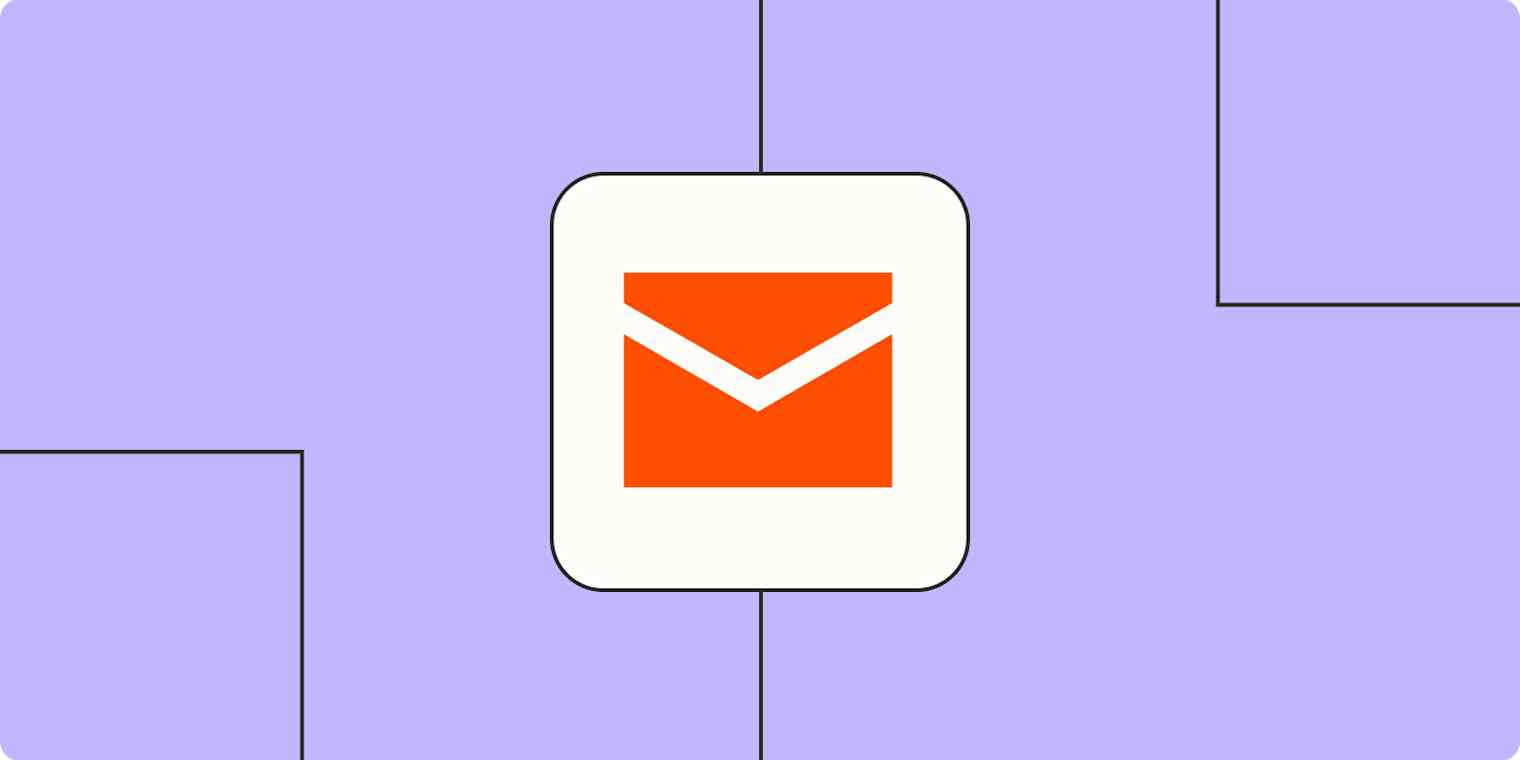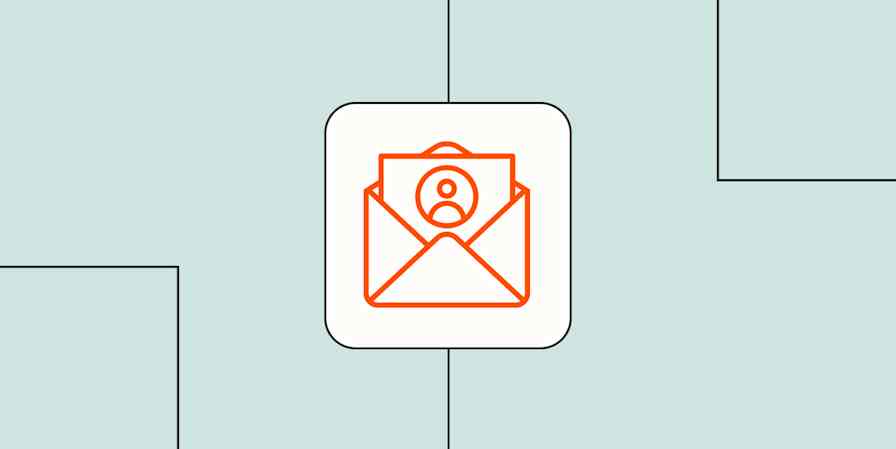Email marketers don't have to contend with constantly changing search algorithms and ranking factors—but that doesn't mean that an email sent is an email received. It's very possible that your marketing emails, and even your transactional emails, will never make it to the recipient.
When I was at Mailshake, we told our clients that while we can automate the way they send email, we can't guarantee that their emails will actually get into their subscribers' inboxes, much less get opened. But we did have some tips for how to improve email deliverability, so you can be sure your messages don't go to spam and result in long-term damage to your business email account.
Table of contents
What is email deliverability?
Your email deliverability rate is the number of emails that actually appear in someone's inbox. You could have a perfectly designed campaign, with the right message and the right audience. But if your emails get flagged as spam or filtered out by email providers, none of that matters—because no one sees them.
Let's say you've built a welcome sequence that's supposed to onboard new users. It's filled with helpful tips, product how-tos, and even a little incentive at the end. But your open rates are weirdly low. You then realize your emails are getting caught by spam filters because your sender reputation took a hit after a big batch of cold outreach last month. That's a deliverability issue.
Or maybe you just redesigned your newsletter with lots of images and fancy formatting—but now it's showing up in Gmail's Promotions tab, and your engagement tanks. Again: a deliverability issue.
Deliverability is the silent gatekeeper between your brand and your audience. It's not just about avoiding spam filters—it's about making sure your emails land where people actually see (and act on) them.
Why does email deliverability matter?
Deliverability is the behind-the-scenes factor that affects everything downstream. If your emails aren't reaching inboxes, you'll see lower engagement. Lower engagement hurts your sender reputation. A poor sender reputation means fewer emails delivered next time. And the cycle continues.
For example, maybe you're running a time-sensitive campaign like a last-chance promo or a product launch announcement. If your message gets filtered out, not only do you lose immediate conversions, but you also chip away at the trust and consistency you've been building with your audience.
You've put in the work building your list, segmenting your audience, and crafting subject lines that actually convert. But if your emails are quietly slipping into spam folders or getting buried in tabs no one checks, you're missing out on opens, clicks, and revenue.
Email deliverability matters because it directly impacts whether your email marketing strategy works. It's not just a technical detail—it's a core part of how you reach your customers.
5 factors that can decrease email deliverability
All emails pass through the provider's ISP (internet service provider) gateway, and the ISP will block any email it thinks is spam. Here are some of the factors that it considers to make that decision.
1. Low sender score and reputation
Sender score is a metric created by Validity that measures your email sender reputation and how email service providers rate your IP address. It considers things like the number of spam complaints you receive, how many unknown or inactive subscribers are in your email list, and whether your domain is on any industry blocklists.

If you have a low sender score, you'll almost certainly have an email deliverability problem.
2. Spammy email content
Spam filters try to identify content that violates email providers' policies. They use algorithms to identify words or phrases that spammers use and look out for bad headers and bulky attachments. And these filters are pretty good: that's why your Gmail spam folder is probably filled to the brim.
The chance of triggering a spam filter is always higher for new recipients, so you need to be extra careful with spam-triggering phrases like "discount," "% off," or "free" when sending to new recipients. On top of going straight to the spam folder, this can risk harming your sender reputation if people report your email or delete it without opening.
3. High bounce rates
When an email bounces, it means that you sent a message to an invalid email address—it can't be delivered because it has nowhere to go. A high email bounce rate indicates one of two things:
You're messaging people you don't know without their consent (not good).
You're not closely managing your email list (also not good).
4. Negative recipient actions
You want the recipient to do something when they get your message: open it, click a link in the email, star it for later, or even reply to it. Those are all positive signals that your content is relevant. If your message goes unopened, immediately deleted, or placed in the spam folder, it's a red flag.
5. Clone phishing attacks
Hackers will often clone a business's display name and forge email headers or messages that look like the business's. It's called spoofing: the goal is to trick your subscribers into thinking a business they know sent them a legitimate message. The message usually contains links or CTAs that redirect users to pages where they're asked to submit sensitive personal information.
Of course, these emails aren't actually coming from your account—but they can impact the trust subscribers have in your brand. It can lead to people deleting your real emails more often without opening them or marking them as spam. Actions like this can result in a poor sender reputation that affects your email deliverability.
9 email deliverability best practices
So you know what can tank your email deliverability rates, but how do you make sure those things don't happen? Here are seven tactics we found helped our clients improve their email deliverability.
1. Warm up your recipients
Thanks to the domain name system (DNS), everything on the internet—including email addresses—has two identifying addresses: the domain name address and the IP address. And if your IP address has a bad reputation, the chances of successfully delivering a message from that address are lower.
To establish your IP's credibility, you need to warm up your email account. At Mailshake, whenever we were sending to a new list, we started by sending emails in small batches. We also avoided sending a high volume of emails in one day or sending emails every day.
Gradually, as emails are received and opened by active users, the ISP will start to trust your IP, and you can increase the number of emails you send. But, of course, you should only send an email when you have something valuable to offer. (And make sure your email frequency generally lines up with your industry's standards).
2. Do a double opt-in confirmation
To reduce your bounce rate, you want to be sure all the emails on your list are actual email addresses. You can do this with email verification tools, but your best bet is to have a double opt-in confirmation. That just means that when someone gives you their email address, they get an email asking them to confirm it.
Here's the double opt-in confirmation email I got from BuzzSumo. All I had to do was click the link, and that was that—not much effort from the user and a lot of benefit for the sender. (Notice that they're super straightforward about why they're sending the email: "to confirm that this is your real email address." Be transparent with your users so they're more likely to follow through.)
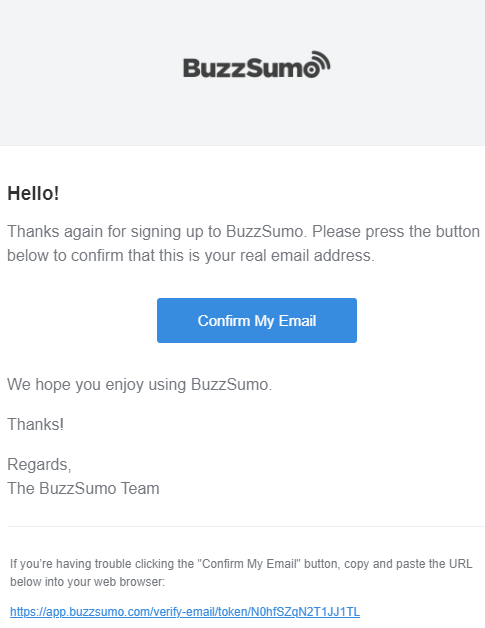
This not only ensures that the email addresses are real, but it also ensures that the subscribers actually want to hear from you.
3. Make the opt-out process easier
It's not just good practice to allow your email subscribers to change their minds: it's also a legal requirement. The CAN-SPAM Act requires email marketers to state that a subscriber can unsubscribe at any time and give them clear instructions for doing so.
I signed up for the Flippa newsletter because I'm personally curious about the value of different online businesses. Flippa offers users options for managing their email preferences or unsubscribing from their newsletter.

Clicking on Unsubscribe brings you to the screen below.
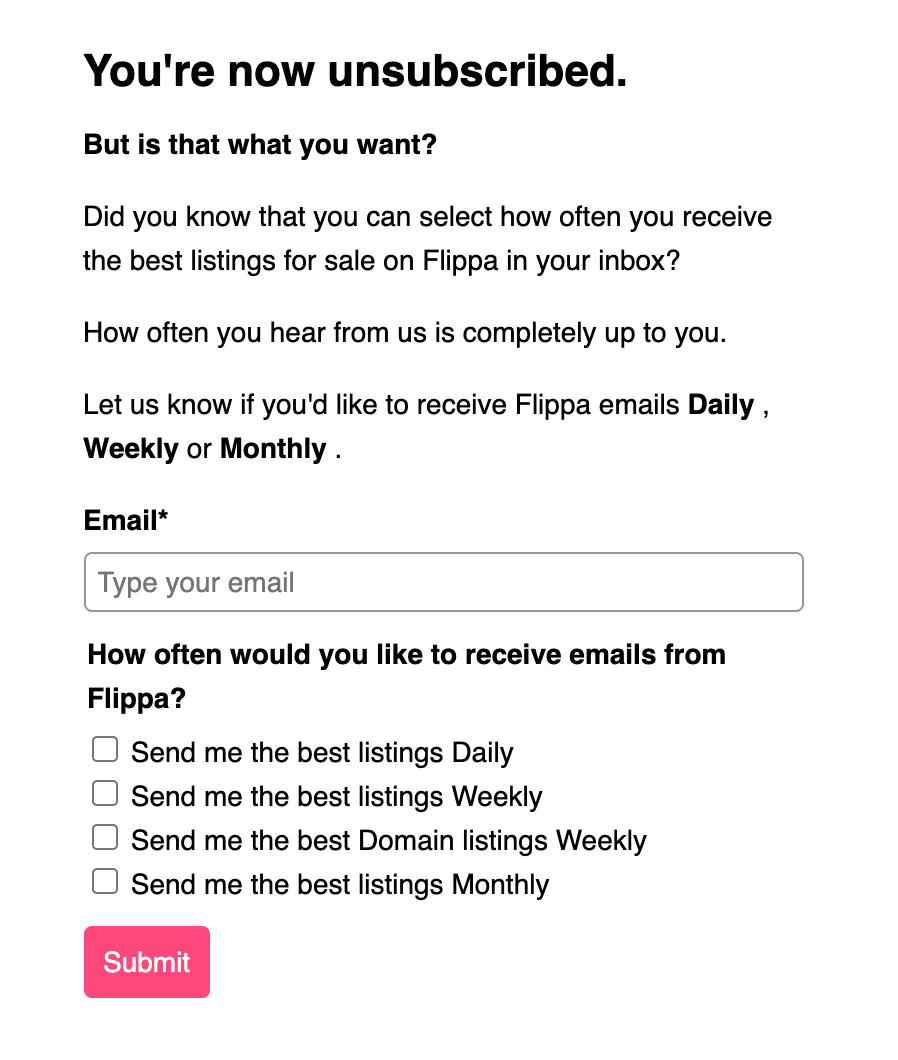
Flippa's opt-out process requires only a single click—no questions asked. But it also gives the user the option to rejoin the email list, even offering different selections for how often to hear from them.
As the sender, your aim should be to increase engagement rates. Creating an easy opt-out process makes sure your email list is up to date and relevant. Don't try to trick people into staying on your list if they don't want to be there—it won't do you any favors.
4. Be consistent with your sender name
Sending emails from a consistent name helps recipients get to know your brand. Sending emails from a wide variety of sender names has the opposite effect: recipients don't know who they're hearing from and whether or not they want to be hearing from them to begin with.
When I signed up for a UK business school's newsletter, I got emails from at least six different sender names—I didn't know which were valuable, and it made me much more likely to click delete since I didn't know what I'd be getting if I opened the email.
You can keep things simple and send from your brand name (e.g., Shopify Digest), but it can be a little more personal if you use your first name and your company's name (e.g., Deb at Zapier or Uche from Bolt).

It's weird that I have to say this, but don't invent a person to have your emails come from. Your sender name should be that of a real human—ideally the one actually writing or scheduling the email.
5. Avoid red flags in email subject lines
You know the types of emails you immediately delete without opening: the ones whose subject lines have spammy characteristics like all-caps, exclamation points, weird fonts, or words like "winner" and "prize." If your internal alarm bells are going off, odds are good that your email client's are, too.
Most email clients have filters in place to weed out spam. To avoid triggering those filters on your marketing emails, keep your email subject lines descriptive and human-sounding without being over the top in any way.
6. Avoid red flags in email body text
The same rule of thumb applies to the body of emails, too. Keeping your email text readable means your reader is less likely to get bored or frustrated enough to unsubscribe (or worse, mark the message as spam).
Here are a few tips to keep in mind when crafting your marketing emails:
Watch your text-to-code ratio. Too much HTML and not enough readable content can trigger spam filters.
Don't attach files to your email. If you need to share something, link to it instead.
Compress your images so they load quickly. Slow-loading emails are a quick path to the trash.
Always include alt text with your images. Some email clients block images by default, and you want readers to know what they're missing.
Keep links to a minimum—and avoid URL shorteners, which can look suspicious to spam filters. Use full, clean links whenever possible.
Skip the bells and whistles. Things like forms, embedded videos, or JavaScript might not show up properly across all inboxes, so keep it simple for better deliverability.
7. Set subscriber expectations
Setting expectations is a good starting point when developing any kind of relationship, and email subscriptions are no exception. In the welcome email series you send to your subscribers, you should share:
The type of content you'll provide
How frequently you'll contact subscribers
A sample of the content you'll send them
Here's the welcome email I received when I signed up for The Balance's newsletter:
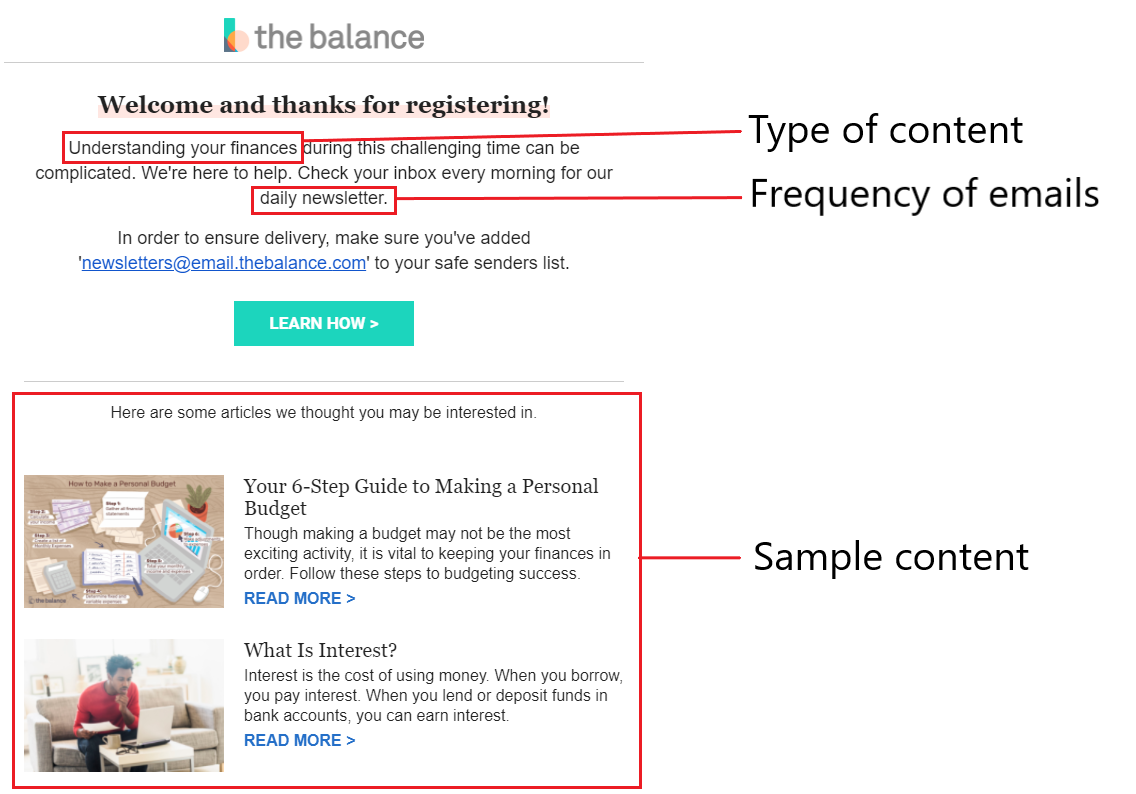
Once you've set those expectations, you need to deliver on them. This is the best way to grow an engaged audience that boosts your deliverability.
8. Segment your email list
Segmenting your audience can help improve email deliverability by increasing your chances of sending relevant content to subscribers, making them more likely to open your emails.
Here are some high-value audiences you can target with segmentation, but your segmentation options are almost endless—and they'll change depending on your industry and your business. The bottom line is that your subscribers don't want a bulk email blast. They want personalized emails that speak to their specific pain points.
9. Clean your email list
If subscribers aren't engaging with your emails, you need to remove them from your email list. I know, you want to have as many subscribers as possible, but an unengaged subscriber can do you much more harm than good.
You should clean your email list regularly. That means removing people who've stopped opening your emails and periodically verifying the email addresses on your list. Email addresses get deactivated all the time as users move to different companies or stop paying for a domain.
One of our largest clients learned this lesson the hard way. They noticed that their email deliverability rates were dropping rapidly, and when they looked into the issue, they discovered that about 10% of their subscribers were using email addresses belonging to a domain that no longer existed. Their business development team discovered that the subscribers' company merged with a Fortune 500 firm and moved over to a new email platform and domain. Once our client removed the inactive email addresses from the list, their email deliverability rate returned to normal.
Here's more detail on how to clean your email list.
Automate your email marketing with Zapier
Once your deliverability is in good shape, it's time to scale your strategy. Automation can help you do that without adding more to your plate.
With Zapier, you can integrate your email marketing tool (like Mailchimp, ActiveCampaign, or Kit) to the rest of your tech stack. Do things like importing leads from forms, turning eCommerce customers into email subscribers, and tagging contacts in your CRM. That means less manual work, fewer dropped leads, and a smoother experience for your subscribers.
Learn more about automating your email marketing, or get started with one of these popular templates.
More details
More details
More details
More details
Note: There are pre-made Zaps—which we call Zap templates—that you can use. Just click a Zap template to begin setting it up. You'll find Zap templates in the App Directory and in many of our blog posts. When you start from a template, you'll find some selections made for you in advance, but you'll always need to connect your app accounts and confirm the setup of each step.
Email deliverability FAQs
What's a good email deliverability rate?
While exact numbers can vary depending on your audience and sending habits, it's a good practice to aim for 95% or higher deliverability. If your rate is below 85%, you're in red flag territory as a high spam risk. Anything in between is a decent score, but still worth checking for issues.
That said, don't confuse deliverability with open rate. An email might be delivered but still go unread if it lands in the Promotions tab or just doesn't grab the reader's attention. So treat deliverability as your baseline—if you're not even clearing the inbox hurdle, nothing else can perform the way it should.
How do I check my email marketing deliverability?
If you're not sure where you stand, your email platform may already track deliverability—or at least bounce rates and inbox placement—so start there before investing in extra tools. But if you want to be extra sure of your email deliverability, try:
Sending a test email to a free inbox testing tool like GlockApps or Mail-Tester to see if it lands in spam.
Checking your sender reputation with Google Postmaster Tools to see if your domain is being flagged (and if so, make sure SPF, DKIM, and DMARC records are correctly set up).
Sending test emails to different inboxes and devices to spot red flags before sending to your full list.
What words trigger spam filters?
Most spam emails try their best to create a sense of urgency or entice the reader into clicking links before their better judgment kicks in. To avoid triggering a spam filter, stay away from words related to money, urgency, or exaggerated claims, like:
Free
Save big
Act now
Click here
Urgent
Don't miss out
Unbelievable
Amazing results
Miracle
Don't sleep on email deliverability
The great thing about focusing on email deliverability is that it has ripple effects for engagement rates: low engagement means low deliverability, but high deliverability can mean high engagement. So keep an eye on your deliverability, and implement these best practices to make sure your emails are getting into your audience's inboxes—and making an impact.
This was a guest post from Sam Molony from Mailshake. It was most recently updated to reflect current best practices in June 2025 by Nicole Replogle. Want to see your work on the Zapier blog? Read our guidelines, and get in touch.
